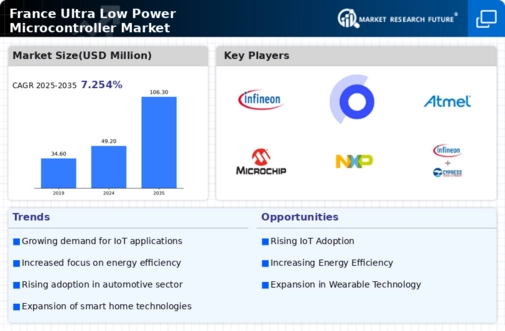Rise of Industrial Automation
The push towards industrial automation in France is creating new opportunities for the ultra low-power-microcontroller market. As industries adopt smart manufacturing practices, the need for efficient control systems becomes paramount. Ultra low-power microcontrollers are integral to various applications, including robotics, sensors, and process control systems. The industrial automation market in France is projected to grow by 20% over the next few years, driven by the need for increased productivity and reduced operational costs. This growth indicates a strong demand for ultra low-power microcontrollers, as they enable real-time data processing and communication while minimizing energy usage. The ultra low-power-microcontroller market is thus positioned to thrive in this evolving landscape.
Advancements in Wearable Technology
The wearable technology sector in France is experiencing rapid growth, which is significantly impacting the ultra low-power-microcontroller market. Devices such as fitness trackers, smartwatches, and health monitoring systems require microcontrollers that consume minimal power to extend battery life. The wearable technology market is expected to grow at a CAGR of 15% over the next five years, highlighting the increasing consumer interest in health and fitness. This trend suggests that manufacturers will continue to invest in ultra low-power microcontrollers to meet the demands of this evolving market. The ultra low-power-microcontroller market is likely to see innovations that enhance performance while maintaining low energy consumption.
Growing Adoption of Smart Home Devices
The increasing integration of smart home devices in France is driving the ultra low-power-microcontroller market. As consumers seek convenience and energy efficiency, manufacturers are focusing on developing devices that utilize ultra low-power microcontrollers. This trend is evident in the rise of smart thermostats, lighting systems, and security cameras, which often rely on these microcontrollers to operate efficiently. According to recent data, the smart home market in France is projected to reach €3 billion by 2026, indicating a robust demand for energy-efficient solutions. The ultra low-power-microcontroller market is poised to benefit from this growth, as these components are essential for enabling the functionality and connectivity of smart devices.
Emergence of Smart Agriculture Solutions
The agricultural sector in France is increasingly adopting smart technologies, which is positively influencing the ultra low-power-microcontroller market. Farmers are utilizing IoT devices for precision farming, which requires microcontrollers that can operate efficiently in remote locations. These devices monitor soil conditions, weather patterns, and crop health, providing valuable data to optimize farming practices. The smart agriculture market is expected to grow significantly, with projections indicating a value of €1.5 billion by 2027. This growth suggests a rising demand for ultra low-power microcontrollers that can support the functionality of these innovative solutions. The ultra low-power-microcontroller market is likely to play a crucial role in enhancing agricultural productivity and sustainability.
Increased Focus on Environmental Sustainability
The growing emphasis on environmental sustainability in France is driving innovation within the ultra low-power-microcontroller market. As consumers and businesses alike prioritize eco-friendly solutions, there is a heightened demand for energy-efficient products. Ultra low-power microcontrollers are essential for developing devices that minimize energy consumption and reduce carbon footprints. The market for energy-efficient electronics is projected to grow by 25% in the coming years, reflecting a shift towards sustainable practices. This trend indicates that manufacturers will increasingly rely on ultra low-power microcontrollers to meet regulatory standards and consumer expectations. The ultra low-power-microcontroller market is thus likely to see a surge in demand as sustainability becomes a key driver of product development.
























Leave a Comment